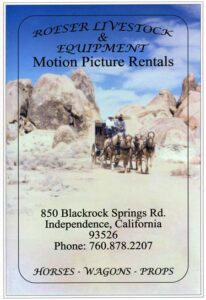
How the West was Shot
John Wilcock
THE TRUE HISTORY of 20th century America unspooled not in New York, Washington, or any other big city, but in the rocky terrain outside a small town in northern California. This would be the Alabama Hills on the outskirts of Lone Pine (pop: 2,035) where, between 1920 and 1960, just about every Western movie you ever heard of was shot.
The Alabama Hills, named by Confederate sympathizers for a trader vessel which sank dozens of Union ships, is a region of sand, scrub, and huge boulders, described by the Lone Pine Chamber of Commerce as “a golden-brown wonderland of rounded hills and twisted rock formations”. As viewers of B-movies will recall, the rocks are certainly distinctive.
A-pictures were shot there too, some starring Gregory Peck (The Gunfighter, 1950); Kirk Douglas (Along the Great Divide, 1951), and Clint Eastwood (Joe Kidd, 1972 ).
The 300 movie-history story of the Hills is not yet over; the BLM is still issuing permits including ones for random TV episodes or car commercials. In 2008 Iron Man starred Robert Downey Jr., followed by the Michael Bay/Steven Spielberg team whose sci-fi blockbuster Transformer 2: The Revenge of the Fallen (2009), overcame critics’ pans to become that year’s second most successful movie (behind Avatar).
Most of the area is public land administered by the Bureau of Land Management which issues 30 or 40 permits per year, all with the requirements to be fire-safe, not to disturb wildlife, vegetation, or artifacts, and remove every piece of trash after filming.
The earliest movies shot in the Alabama Hills, both in 1920, were Water, Water Everywhere with Will Rogers which concerned a group of women temperance advocates who managed to close down a local saloon, and The Round Up (Paramount, 1920) with Roscoe (Fatty) Arbuckle and Wallace Beery, adapted from a 1907 Broadway play. Fatty, previously a Keystone Cop in Mack Sennet’s one-reelers, emerged as a star from this, his first full-length movie.
Dave Holland, wrote in his On Location in Lone Pine, that when he first drove out through the rocks and bush in the Alabama Hills he knew he had been there before “This is the Khyber Pass” (he told himself). “I don’t care what the sign says, This is the Khyber Pass.
“Stare off into those rocks and your mind presses the nostalgia button and the past is here again and the voices get louder and you remember that a young boy’s heart will break and he’ll lose the ranch his dad had left him if Gene Autry and Champion don’t win that race…”
And it’s true that history is on hold here, the scenery barely changed, used over and over again in different contexts and representing different countries. A collection of boulders known as the Background Rocks, for example, popped up in Lives of a Bengal Lancer (1935), Rawhide (1940), In Old Colorado (1941), How the West Was Won (1962) among countless others.
You, too, can pose before these distinctive rocks that have back-dropped Hopalong Cassidy and Gene Autry, Erroll Flyn and Robert Mitchum, as well as the thousand or more extras in George Stevens’ Gunga Din (1940) the colossal epic filmed by RKO in 1938. Including hundreds of horses and mules and four elephants, Gunga Din eventually cost $2million and, with its 200-strong crew and nine writers who lived in tents on site for weeks, was the biggest of the string of movies set in the rugged Northwest Frontier, their protagonists engaged in the seemingly endlessly task of preserving the British Empire.
Holland’s superlative On Location in Lone Pine (Holland House, 1990) is filled with wonderful anecdotes and vignettes such as the time when Allen Jones on horseback, riding alongside Jeanette MacDonald in a coach sings Donkey Serenade, a genuine background that in The Firefly (1937) was replaced by a rear projection screen. And he refers to visits by Mel Gibson, James Garner, and Jodie Foster and quotes the Lone Ranger’s director William Witney as nominating Roy Rogers as the best horseman of all the cowboy heroes.
The old legend about gangs of crooks galloping across the set, followed by a quick change of hats and shirts and then a gallop back as the posse chasing them, is absolutely true, writes Holland. They actually happened.
Among the hundreds of other films shot here in the Alabama Hills, were The Gay Caballero (1940) with Cesar Romero playing the Cisco Kid, a Robin Hood character created in a short story by O.Henry; Tarzan’s Desert Mystery (1943); and Rawhide (1951) starring Tyrone Power and Susan Hayward whose set is a stagecoach stop taken over by escaped convicts awaiting a shipment of gold. In 1962 How the West Was Won won MGM/Cinerama three Oscars. Its five segments featured 630 horses, 150 mules, and 107 wagons.
THOUSANDS OF FANS come from all over the world to attend the Lone Pine Film Festival which this year is scheduled for October 7-9 and which will feature stunt shows, a cowboy church ceremony, Sunday parade and tours. A new addition will be the Tom Mix Tour visiting the mountain site where Riders of the Purple Sage (1924) built adobe huts. Mix and his horse, Tony, made three other movies here: Just Tony (1922), Flaming Guns (1932), and Terror Trail (1932).
Other tours will be to locales of films starring the WW2 hero Audie Murphy, Posse From Hell (1961), Showdown (1973), and Hell Bent For Leather (1970). The last also featured Polly Burson, a teenage rodeo trick rider who became known as “Queen of Western Stuntwomen;” and a World Tour. This includes where John Wayne drilled a railroad tunnel through the Andes in Tycoon (1947); the Persian campsite from The Adventures of Hajji Baba (1955) whose cast included Playboy models; and where Bengal Lancers rode; as well as the former tent city from Gunga Din (1939) an adaptation of Rudyard Kipling’s novel in which a trio of rowdy soldiers was played by Cary Grant, Douglas Fairbanks Jr., and Victor McLaglen.
The idea for the festival came from Lone Pine local Kerry Powell who watched filming in Alabama Hills as a child and later, with her husband, decorated their Frontier Motel with movie stills and posters. A partnership ensued with Dave Holland, the local photographer for commercials who compiled his well-researched history after continually recognizing sites from B-movies he had seen. He was a natural for the Festival’s director. He died in 2005 and this year’s Dave Holland Tour visits some of his favorite locations.
There are numerous helpful lists to guide visitors on their own tours of the terrain, beginning with a left turn west at the traffic light on Lone Pine’s Main Street. Here on Whitney Portal Road is where Brigham Young’s Dean Jagger in 1940 looked out to see the future Salt Lake City, and in 1953, Tyrone Power led his troops in King of the Khyber Rifles. Half a mile from town you’ll cross the aqueduct completed in 1913 to supply water to Los Angeles 180 miles to the southwest. The solitary Jeffrey pine tree above the aqueduct replaces the original one that gave the town its name but which blew down in a wind storm in 1892.
The entire unpaved area, studded with bush and sprawling boulders and criss-crossed by dirt tracks once used to move heavy film equipment, is unsafe to drive today, warns the literature which urges drivers to stay on the roads. A white historical sign marks the turn right onto Movie Road, part-paved and passing through areas used in a military training film for combat soldiers in Afghanistan made this year.
Not a trace remains of Warner Brothers’ early Technicolor movie Song of the West (1930) with its Red Dog Saloon, but just right of Movie Road are a cluster of sites known as the Gary Cooper Rock, the Gene Autry Rock, the Bengal Curve, and the site where outlaws killed every member of a Texas Rangers group except one — the Lone Ranger (1938).
At 3.8 MILES is where Roy Rogers starred in Under Western Stars (Republic, 1938) playing an everyman elected to Congress to bring water to drought-starved ranchers. He strummed on a guitar in the movie, and one of his songs won an Oscar. The role had originally been destined for Gene Autry who unluckily was in dispute with Republic at the time. (The guitar sold in April 2009 for $460,000.)
At 5.4 MILES is the spot where John Wayne, with recognizable rocks in background, made a headache remedy commercial (Datril 500) in 1978.
At Moffat Ranch Road (7.9 MILES) was the site of Salt Lake City for Brigham Young (1940) with all-star cast which included Vincent Price, Tyrone Power, Linda Darnell.
Five miles further west back down at the end of Whitney Portal Road — “a dead end for that Dead End gangster” — is the camp (8,631 ft) for most of the aspiring 10,000 climbers with permits who assay the climb each year. Steep, sharp switchbacks punctuate the road which features in two films: The Long Long Trailer (1954) wherein Lucille Ball surreptitiously fills their travel trailer with souvenir rocks, making it too heavy to climb the grade; and High Sierra (1941) with Humphrey Bogart, an early heist film written by John Huston and W.R. Burnett (from his book), the film in which Bogart first became a leading man. The 1937 Plymouth Coupe seen in the movie now welcomes visitors at the film museum in town.
ONE OF AMERICA’s most interesting collections can be admired at The Museum of Lone Pine Film History with its vast assembly of vintage movie posters, cowboy hats, guns, silver saddles, and richly decorated costumes. Dominating the rear of the lobby is a spotless, authentic-looking stagecoach which may or may not have had a real life on some early route (the museum won’t — or can’t — say) but must have starred in a movie or three.
A 1941 Buick, festooned with pistols and longhorns plus embedded silver dollars appeared in the 1946 film, Trail to San Antonio. The film’s star was Gene Autry, but it was his stuntman stand-in Joe Yrfoyen who jumped over the car astride Autry’s nag, Champion.
There’s an exhibit devoted to the 1990 cult classic Tremors with its voracious graboid, a three-headed worm, and whose description as a science fiction comedy seems only bolstered by a website devoted to listing 41 of the movie’s “mistakes” (a sack thrown by one character is seen as a different sack when caught; a lawnmower clearly seen to be pulled by a hidden wire).
Highlight of the museum is an absorbing fast-moving 10-minute movie that segues segments of one classic Western after another. Highly commendable is the museum’s policy of keeping its admission fee at a meager five dollars, leaving visitors with spare change to buy from the wide array of books and postcards irresistible to movie buffs.
Memberships in the museum are invited, ranging from the low-rent Maverick classification to Gunga Din to Lights of the Western Stars ($4 thou).

SINCE THE EARLIEST days of filmmaking in the Alabama Hills, equipment companies have supplied all the moviemakers’ needs. This picture is from the brochure of the Independence, CA, company of Roester Livestock & Equipment, which has been providing stock — wranglers, horses, mules, cowboy artifacts — for 40 years. They have collaborated on commercials for Camel, Cannon, Chrysler, Dunkin’ Donuts and also worked on How the West was Won.

